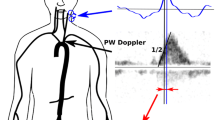Summary
The measurement accuracy of clinically applicable methods for blood flow measurement in coronary sinus — continuous local thermodilution (LTD), differential pressure (DP), ultrasonic Doppler (US) and the electromagnetic flow measurement method (EMF) — was examined in 15 anaesthetized closed chest dogs with left ventricle weights between 150 and 200 g. The LTD, DP, US and the EMF were examined in each experiment in the two following arrangements.
-
1.
In coronary sinus — left jugular vein by-pass: This arrangement allowed four reference methods for measurement of coronary sinus blood flow (CBF).
-
2.
In “clinical” position, without by-pass, which allowed two reference methods for CBF measurements.
The results on the measurement accuracy of the LTD, DP and US are, depending on the measurement arrangement, contradictory. In the by-pass arrangement 1 there was observed a good agreement of the LTD, DP and US CBF values with the reference values. In the “clinical” position, without by-pass 2 the measurement accuracy of LTD was not sufficient forexact measurement of CBF and derived parameters. The examined velocity tip flow probes (US, DP) gave no correlation with the reference methods. US and DP are even for semiquantitative estimation of CBF unsuitable. The EMF tip flow probe was for the CBF measurement unsuitable, because of disturbance by the electrical activity of myocardium.
Zusammenfassung
Einfache, klinisch einsetzbare Verfahren zur Durchblutungsmessung im Koronarsinus — die kontinuierliche lokale Thermodilution (LTD) sowie drei Blutgeschwindigkeitsmeßsonden nach dem Druckdifferenzprinzip (DD), dem Ultraschall-Doppler-Prinzip (US) und dem Elektromagnetischen Prinzip (EMF)-wurden an 15 narkotisierten Hunden mit linksventrikulären Gewichten um 200 g auf ihre Meßgenauigkeit untersucht. LTD, DD, US und EMF wurden in jedem Experiment in zwei Testanordnungen eingesetzt:
-
1.
In einem Koronarsinus-Jugularvenen-Bypass. In dieser Testanordnung standen vier Referenzmeßverfahren zur Bestimmung der Myokarddurchblutung (MBF) zur Verfügung.
-
2.
In einer kliniknahen Einsatzform, ohne Bypass. In dieser Anordnung konnten zwei Referenzverfahren eingesetzt werden.
Bei Einsatzform 1 wurde für alle Verfahren (LTD, US, DD) eine gute Meßgenauigkeit festgestellt. In der kliniknahen Einsatzform 2 ist die Meßgenauigkeit der LTD soweit reduziert, daß keine exakten Aussagen über MBF und abgeleitete Größen zu erhalten sind. Die untersuchten Geschwindigkeitsmeßsonden DD und US gaben in der kliniknahen Einsatzform keine Korrelation zu den Referenzmethoden. Das verwendete elektromagnetische Tipflowmeter war beim Einsatz im Koronarsinus wegen der Myokardpotentialstörungen unbrauchbar.
Similar content being viewed by others
Literatur
Ganz, W., K. Tamura, H. S. Marcus, R. Donoso, S. Yoshida andH. J. C. Swan: Measurement of Coronary Sinus Blood Flow by Continuous Thermodilution in Man. Circulation44, 181–195 (1971).
Benchimol, A., H. F. Stegall, J. L. Gartlan: New Method to Measure Phasic Coronary Blood Velocity in Man. Amer. Heart J.81, 93–101 (1971).
Shillingford, J., O. Müller: The Blood Flow in the Right Atrium and Superior Vena Cava in Tricuspid Incompetence. Brit. Heart J.17, 163–168 (1954).
Bretschneider, H. J., L. Cott, G. Hilgert, R. Probst, G. Rau: Gaschromatographische Trennung und Analyse von Argon als Basis einer neuen Fremdgasmethode zur Durchblutungsmessung von Organen. Verh. Dtsch. Ges. Kreisl.-Forschg.32, 267–273 (1966).
Bretschneider, H. J., L. A. Cott, G. Hellige, I. Hensel, D. Kettler, J. Martel: A New Haemodynamic Parameter Consisting of 5 Additive Determinants for Estimation of the O2 Consumption of the Left Ventricle. Int. Congress Physio. Sci. München 1971.
Bassan, M., W. Ganz, H. S. Marcus, H. J. C. Swan: The Effect of Intracoronary Injection of Contrast Medium upon Coronary Blood Flow. Circulation51, 442–445 (1976).
Stein, P. D., H. S. Badeer, W. H. Schuette, A. E. Zencka: Velocity of Coronary Sinus Blood Flow as an Indicator of Coronary Arterial Flow. Amer. Heart J.80, 202–209 (1970).
Mathey, D. G., K. Chatterjee, J. Lekven, J. V. Tyberg, W. W. Parmley: Right Atrial Admixture in Coronary Sinus Blood. Proceedings of the international union of Physiological Sciences,13, 487 (1977).
Author information
Authors and Affiliations
Additional information
With 4 figures and 3 tables
Supported by the Deutsche Forschungsgemeinschaft, SFB 89 — Kardiologie Göttingen
Rights and permissions
About this article
Cite this article
Sigmund-Duchanova, H., Baller, D., Bretschneider, H.J. et al. Experimental validation of methods for the measurement of coronary sinus blood flow in man. Basic Res Cardiol 74, 277–287 (1979). https://doi.org/10.1007/BF01907745
Received:
Issue Date:
DOI: https://doi.org/10.1007/BF01907745




